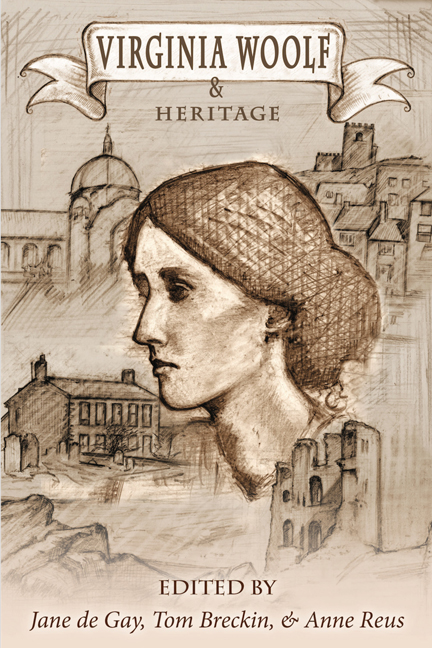Book contents
- Frontmatter
- Contents
- Introduction
- List of Abbreviations
- HERITAGE: A DEBATE
- HERITAGE, EDUCATION, AND MENTORING
- HERITAGE SPACES
- LITERARY AND CULTURAL HERITAGES
- QUEER PASTS
- MODERNISM AND HERITAGE
- WRITING LIVES AND HISTORIES
- WOOLF'S LEGACIES
- “A shadow crossed the tail of his eye”: The Reception of Virginia Woolf in Romania: Heritage Transformed
- Woolf 's Imaginarium: Exploring Virginia Woolf 's Legacy to Contemporary Polish Culture
- An Office of Her Own? Alice Munro and the Legacy of Writing with In-Authority
- Thinking Back through Virginia Woolf: Woolf as Portal in Lidia Yuknavitch's The Small Backs of Children
- The Malicious Gene: An Evolutionary Games Strategy? Woolf 's Hawkish Inheritance
- FINALE
- Notes on Contributors
Woolf 's Imaginarium: Exploring Virginia Woolf 's Legacy to Contemporary Polish Culture
from WOOLF'S LEGACIES
- Frontmatter
- Contents
- Introduction
- List of Abbreviations
- HERITAGE: A DEBATE
- HERITAGE, EDUCATION, AND MENTORING
- HERITAGE SPACES
- LITERARY AND CULTURAL HERITAGES
- QUEER PASTS
- MODERNISM AND HERITAGE
- WRITING LIVES AND HISTORIES
- WOOLF'S LEGACIES
- “A shadow crossed the tail of his eye”: The Reception of Virginia Woolf in Romania: Heritage Transformed
- Woolf 's Imaginarium: Exploring Virginia Woolf 's Legacy to Contemporary Polish Culture
- An Office of Her Own? Alice Munro and the Legacy of Writing with In-Authority
- Thinking Back through Virginia Woolf: Woolf as Portal in Lidia Yuknavitch's The Small Backs of Children
- The Malicious Gene: An Evolutionary Games Strategy? Woolf 's Hawkish Inheritance
- FINALE
- Notes on Contributors
Summary
In recent years, the popularity of Virginia Woolf's oeuvre has substantially increased in Poland. There has been little prior attempt to explain “Woolf's Renaissance,” although it can be beneficial to comparative literature and reception studies. In contrast with numerous works on Woolf 's influence on American and British culture, there has been no research into Polish intertextual dialogues with this author. Therefore, the aim of this paper is to examine Virginia Woolf 's legacy to contemporary Polish culture, as well as its possible causes. To illustrate the scope of “Woolf 's Renaissance,” I would like to quote Sylwia Chutnik, a Polish writer:
I would never rid myself of admiration for Virginia Woolf…For my generation of thirty-year-old feminists, Woolf was one of the most important teachers. She wrote, among others, about the androgynous character (Orlando), exceeding the dull sexual dualism. She shared with us the stream of consciousness (The Waves). And finally, she gave us A Room of One's Own— that is the possibility of being an independent artist without the feelings of guilt and shame.1 (Chutnik, “Jakub od Virginii”)
This brings us to the question of why Woolf 's oeuvre has become such an important influence on Polish women writers at the turn of the centuries? The first thing to consider is her delayed reception in Poland and the recent revival of interest. Furthermore, Woolf 's formal experiments could be inspiring for the postmodernist writers. Finally, as Urszula Terentowicz-Fotyga has pointed out, Woolf “seems to write herself much better into the contemporary Polish context than other modernists” (127). As Claire Davison has shown, Woolf 's “versatility” is connected with her ability of “working from a sense of dislocation—an outland or landscape gradually revealed to the mind that is neither homely and familiar, nor closed, alien, and unknowable” (73). Yet, I will suggest that Polish intellectuals also find Woolf so inspiring because of the similarities between the patriarchal culture of interwar Britain and contemporary Poland.
Towards ‘Woolf's Renaissance’
Terentowicz-Fotyga established that Woolf 's reception in Poland develops from “silence to a polyphony of voices” and could be divided into three phases (127–8). In the first period, which extended until the late 1950s, she remained relatively unknown.
- Type
- Chapter
- Information
- Virginia Woolf and Heritage , pp. 236 - 243Publisher: Liverpool University PressPrint publication year: 2017



